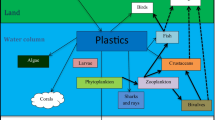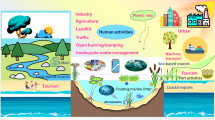Abstract
The majority of consumer products used today are comprised of some form of plastic. Worldwide, almost 280 million t of plastic materials are produced annually, much of which ends up in landfills or the oceans (Shaw and Sahni Journal of Mechanical and Civil Engineering 46–48, 2014). While plastics are lightweight, inexpensive, and durable, these same qualities can make them very harmful to wildlife, especially once they become waterborne. Once seaborne, plastics are most likely found circulating in one of five major ocean gyres: two in the Pacific, one in the Indian, and two in the Atlantic. These ocean garbage patches are not solid islands of plastic; instead, they are a turbid mix of plastics (Kostigen 2008; Livingeco 2011). Recent research conducted on the surfaces of the Great Lakes has identified similar problems (Erikson et al. Marine Pollution Bulletin, 77(1), 177–182, 2013). A growing concern is that once plastics reach the wild, they may cause entanglement, death from ingestion, and carry invasive species. Several cutting edge technologies have been piloted to monitor or gather the plastics already in our environments and convert them back into oil with hopes to reduce the damage plastics are causing to our ecosystems.
Similar content being viewed by others
References
Allen, R., Jarvis, D., Sayer, S., & Mills, C. (2012). Entanglement of grey seals Halichoerus grypus at a haul out site in Cornwall, UK. Marine Pollution Bulletin, 64(12), 2815–2819.
Auman, H. J., Ludwig, J. P., Giesy, J. P., & Colborn, T. H. E. O. (1997). Plastic ingestion by Laysan albatross chicks on Sand Island, Midway Atoll, in 1994 and 1995. Albatross Biology and Conservation, 239–244.
Avery-Gomm, S., Provencher, J. F., Morgan, K. H., & Bertram, D. F. (2013). Plastic ingestion in marine-associated bird species from the eastern North Pacific. Marine Pollution Bulletin, 72(1), 257–259.
Baird, R. W., & Hooker, S. K. (2000). Ingestion of plastic and unusual prey by a juvenile harbour porpoise. Marine Pollution Bulletin, 40(8), 719–720.
Baulch, S., & Perry, C. (2014). A sea of plastic: evaluating the impacts of marine debris on cetaceans. Marine Pollution Bulletin, 80(1), 210–221.
Blackwell, B. (2012). Record levels of plastic pollution found in Lake Erie. Northeast Ohio Media Group. Retrieved from http://www.cleveland.com/metro/index.ssf/2012/12/record_levels_ of_plastic_pollu.html.
Blight, L. K., & Burger, A. E. (1997). Occurrence of plastic particles in seabirds from the eastern North Pacific. Marine Pollution Bulletin, 34(5), 323–325.
Boerger, C. M., Lattin, G. L., Moore, S. L., & Moore, C. J. (2010). Plastic ingestion by planktivorous fishes in the North Pacific Central Gyre. Marine Pollution Bulletin, 60(12), 2275–2278.
Boyle, R. (2012). Plastic-eating underwater drone could swallow the great pacific garbage patch. Popular Science. Retrieved from http://www.popsci.com/technology/article/2012-07/plastic-eating-underwater-drone-could-swallow-great-pacific-garbage-patch
Dau, J. (2012). The Great Lakes have some of world’s most concentrated plastic pollution. Great Lakes Echo. Retrieved from http://greatlakesecho.org/2012/10/29/the-great-lakes-have-some-of-the-worlds-greatest-concentrations-of-plastic-pollution/
Davison, P., & Asch, R. G. (2011). Plastic ingestion by mesopelagic fishes in the North Pacific Subtropical Gyre. Marine Ecology Progress Series, 432, 173–180.
de Stephanis, R., Giménez, J., Carpinelli, E., Gutierrez-Exposito, C., & Cañadas, A. (2013). As main meal for sperm whales: plastics debris. Marine Pollution Bulletin, 69(1), 206–214.
DiGregorio, B. E. (2012, February). Tracking Plastic in the Ocean. Earth, n.a, 28–35.
EPA (2012). Great Lakes Water Quality Agreement. Retrieved from http://www.epa.gov/greatlakes/glwqa/index.html.
EPA (2013). Health Effects of PCBs. Retrieved from http://www.epa.gov/epawaste/hazard/tsd/pcbs/pubs/effects.htm.
EPA (2014). Plastics. Retrieved from http://www.epa.gov/osw/conserve/materials/plastics.htm.
Eriksen, M., Mason, S., Wilson, S., Box, C., Zellers, A., Edwards, W., & Amato, S. (2013). Microplasticpollution in the surface waters of the Laurentian Great Lakes. Marine Pollution Bulletin, 77(1), 177–182.
Foekema, E. M., De Gruijter, C., Mergia, M. T., van Franeker, J. A., Murk, A. J., & Koelmans, A. A. (2013). Plastic in North sea fish. Environmental Science & Technology, 47(15), 8818–8824.
Foley, J. (2014). Endangered Right Whale has ‘Fighting Chance’ After Being Disentangled off Georgia Coast. Nature World News RSS. Retrieved from http://www.natureworldnews.com/articles/6122/20140220/endangered-right-whale-fighting-chance-being-disentangled-georgia-coast-video.htm.
Gill, V. (2010). Plastic Rubbish Blights Atlantic Ocean. BBC News, 24.
Greengard, S. (2010). Tracking garbage. Communications of the ACM, 53(3), 19–20.
Gregory, M. R. (2009). Environmental implications of plastic debris in marine settings—entanglement, ingestion, smothering, hangers-on, hitch-hiking and alien invasions. Philosophical Transactions of the Royal Society, B: Biological Sciences, 364(1526), 2013–2025.
Jacobsen, J. K., Massey, L., & Gulland, F. (2010). Fatal ingestion of floating net debris by two sperm whales (Physeter macrocephalus). Marine Pollution Bulletin, 60(5), 765–767.
Kostigen, T. M. (2008). The world’s largest dump: the great pacific garbage patch. Discover Magazine, 10.
Laist, D. W. (1997) Impacts of marine debris: entanglement of marine life in marine debris including a comprehensive list of species with entanglement and ingestion records. In J. M. Coe & D. B. Rogers (Eds.), Marine Debris: Sources, Impacts, and Solutions (pp. 99–140). New York: Springer.
Livingeco (2011, November 1). The Clean Oceans Project/Plastic to Oil Machine. [YouTube]. Retrieved from http://www.youtube.com/watch?v=8qBFlOqLnJ8.
Lusher, A. L., McHugh, M., & Thompson, R. C. (2013). Occurrence of microplastics in the gastrointestinal tract of pelagic and demersal fish from the English Channel. Marine Pollution Bulletin, 67(1), 94–99.
Martinez, E., Maamaatuaiahutapu, K., & Taillandier, V. (2009). Floating marine debris surface drift: convergence and accumulation toward the South Pacific subtropical gyre. Marine Pollution Bulletin, 58(9), 1347–1355.
Mascarenhas, R., Santos, R., & Zeppelini, D. (2004). Plastic debris ingestion by sea turtle in Paraı́ba, Brazil. Marine Pollution Bulletin, 49(4), 354–355.
Maximenko, N., Hafner, J., & Niiler, P. (2012). Pathways of marine debris derived from trajectories of Lagrangian drifters. Marine Pollution Bulletin, 65(1), 51–62.
McLendon, R. (2010). What is the Great Pacific Ocean Garbage Patch? Mother Nature Network. Retrieved fromhttp://www.mnn.com/earth-matters/translating-uncle-sam/stories/what-is-the-great-pacific-ocean-garbage-patch.
Moore, C. J. (2008). Synthetic polymers in the marine environment: a rapidly increasing, long-term threat. Environmental Research, 108(2), 131–139.
Moser, M. L., & Lee, D. S. (1992). A fourteen-year survey of plastic ingestion by western North Atlantic seabirds. Colonial Waterbirds, 15(1), 83–94.
Mrosovsky, N., Ryan, G. D., & James, M. C. (2009). Leatherback turtles: the menace of plastic. Marine Pollution Bulletin, 58(2), 287–289.
Nelson, B. (2011). What can 28,000 rubber duckies lost at sea teach us about our oceans? Mother NatureNetwork. Retrieved from http://www.mnn.com/earth-matters/wilderness-resources/stories/what-can-28000-rubber-duckies-lost-at-sea-teach-us-about.
NOAA (2008). Currents. Retrieved from http://oceanservice.noaa.gov/education/kits/currents/05currents3.html
NOAA (2013). Where are the Pacific Garbage Patches? Retrieved from http://response.restoration.noaa.gov/about/media/where-are-pacific-garbage-patches.html
NOAA (2014). How Debris Accumulates. Retrieved from http://marinedebris.noaa.gov/movement/how-debrisaccumulates.
Oehlmann, J., Schulte-Oehlmann, U., Kloas, W., Jagnytsch, O., Lutz, I., Kusk, K. O., & Tyler, C. R. (2009). A critical analysis of the biological impacts of plasticizers on wildlife. Philosophical Transactions of the Royal Society, B: Biological Sciences, 364(1526), 2047.
Parker, D. M., Cooke, W. J., & Balazs, G. H. (2005). Diet of oceanic loggerhead sea turtles (Caretta caretta) in the central North Pacific. Fishery Bulletin, 103(1), 142–152.
Plot, V., & Georges, J. Y. (2010). Plastic Debris in a Nesting Leatherback Turtle in French Guiana. Chelonian Conservation and Biology, 9(2), 267–270.
Provencher, J. F., Gaston, A. J., Mallory, M. L., O’hara, P. D., & Gilchrist, H. G. (2010). Ingested plastic in a diving seabird, the thick-billed murre (Uria lomvia), in the eastern Canadian Arctic. Marine Pollution Bulletin, 60(9), 1406–1411.
Rochman, C. M., Lewison, R. L., Eriksen, M., Allen, H., Cook, A. M., & Teh, S. J. (2014). Polybrominated diphenyl ethers (PBDEs) in fish tissue may be an indicator of plastic contamination in marine habitats. Science of the Total Environment, 476, 622–633.
Ryan, P. G. (1988). Effects of ingested plastic on seabird feeding: evidence from chickens. Marine Pollution Bulletin, 19(3), 125–128.
Ryan, P. G., Moore, C. J., van Franeker, J. A., & Moloney, C. L. (2009). Monitoring the abundance of plastic debris in the marine environment. Philosophical Transactions of the Royal Society, B: Biological Sciences, 364(1526), 1999–2012.
Sarker, M., Rashid, M. M., Molla, M., & Sadikur Rahman, M. (2012a). A new technology proposed to recycle waste plastics into hydrocarbon fuel in USA. International Journal of Energy & Environment, 3(5), 749–760.
Sarker, M., Rashid, M. M., Rahman, M. S., & Molla, M. (2012b). Polypropylene waste plastic into light fractional gasoline grade fuel for vehicle by using two step thermal process. International Journal of Forest, Soil and Erosion (IJFSE), 2(4), 186–191.
Sarker, M., Rashid, M. M., Molla, M., & Rahman, M. S. (2012c). Thermal conversion of waste plastics (HDPE, PP and PS) to produce mixture of hydrocarbons. American Journal of Environmental Engineering, 2(5), 128–136.
Secchi, E. R., & Zarzur, S. (1999). Plastic debris ingested by a Blainville’s beaked whale, Mesoplodon densirostris, washed ashore in Brazil. Aquatic Mammals, 25(1), 21–24.
Shaw, D. K., & Sahni, P. (2014). Plastic to oil. Journal of Mechanical and Civil Engineering, 46–48.
Sheng, J., & Rao, Y. R. (2006). Circulation and thermal structure in lake Huron and Georgian Bay: application of a nested-grid hydrodynamic model. Continental Shelf Research, 26(12), 1496–1518.
Shillinger, G. L., Di Lorenzo, E., Luo, H., Bograd, S. J., Hazen, E. L., Bailey, H., & Spotila, J. R. (2012). On the dispersal of leatherback turtle hatchlings from Mesoamerican nesting beaches. Proceedings of the Royal Society B: Biological Sciences, 279(1737), 2391–2395.
Simmonds, M. P. (2012). Cetaceans and marine debris: the great unknown. Journal of Marine Biology, 2012.
Singh, T. (2013). 19-Year-Old Develops Ocean Cleanup Array That Could Remove 7,250,000 Tons of Plastic from the World’s Oceans. Retrieved from http://inhabitat.com/19-year-old-student-develops-ocean-cleanup-array-that-could-remove-7250000-tons-of-plastic-from-the-worlds-oceans/.
Stamper, M. A., Spicer, C. W., Neiffer, D. L., Mathews, K. S., & Fleming, G. J. (2009). Morbidity in a juvenile green sea turtle (Chelonia mydas) due to ocean-borne plastic. Journal of Zoo and Wildlife Medicine, 40(1), 196–198.
Teuten, E. L., Saquing, J. M., Knappe, D. R., Barlaz, M. A., Jonsson, S., Björn, A., & Takada, H. (2009). Transport and release of chemicals from plastics to the environment and to wildlife. Philosophical Transactions of the Royal Society, B: Biological Sciences, 364(1526), 2027–2045.
The Ocean Clean-Up. (2014). The Concept. Retrieved from http://www.theoceancleanup.com/the-concept.html.
Tomas, J., Guitart, R., Mateo, R., & Raga, J. A. (2002). Marine debris ingestion in loggerhead sea turtles, Caretta caretta, from the Western Mediterranean. Marine Pollution Bulletin, 44(3), 211–216.
van Franeker, J. A., Blaize, C., Danielsen, J., Fairclough, K., Gollan, J., Guse, N., & Turner, D. M. (2011). Monitoring plastic ingestion by the northern fulmar fulmarus glacialis in the North Sea. Environmental Pollution, 159(10), 2609–2615.
Wabnitz, C., & Nichols, W. J. (2010). Plastic pollution: an ocean emergency. Marine Turtle Newsletter, 129, 1–4.
Want to track Marine Debris? There’s an App for that (2014). Southeast Atlantic Marine Debris Initiative. Retrieved from http://sea-mdi.engr.uga.edu/want-to-track-marine-debris-theres-an-app-for-that/.
What a Waste. (2010). Plastic Oceans. Retrieved from http://www.plasticoceans.net/the-facts/what-a-waste/.
Zbyszewski, M., & Corcoran, P. L. (2011). Distribution and degradation of fresh water plastic particles along the beaches of lake Huron, Canada. Water, Air, & Soil Pollution, 220(1), 365–372.
Acknowledgments
The author would like to thank J. Kainz, D. Wilkin, and N. Zegar for their assistance with the editing of this manuscript.
Author information
Authors and Affiliations
Corresponding author
Rights and permissions
About this article
Cite this article
Sigler, M. The Effects of Plastic Pollution on Aquatic Wildlife: Current Situations and Future Solutions. Water Air Soil Pollut 225, 2184 (2014). https://doi.org/10.1007/s11270-014-2184-6
Received:
Accepted:
Published:
DOI: https://doi.org/10.1007/s11270-014-2184-6




